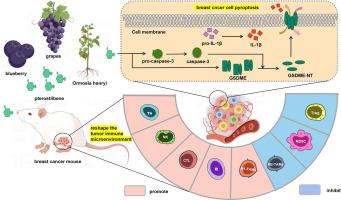紫檀芪通过caspase-3/Gasdermin E信号通路诱导小鼠乳腺癌细胞焦亡,重塑肿瘤免疫微环境
IF 5
2区 医学
Q2 Medicine
引用次数: 0
摘要
越来越多的证据表明,摄入特定的膳食补充剂可能会降低患乳腺癌的风险。紫檀芪(PTE)是一种广泛存在于浆果中的天然苯乙烯化合物,以剂量依赖性方式诱导EMT6和4T1细胞焦亡。此外,si Gasdermin E (GSDME)和Z-DEVD-FMK(一种caspase-3酶活性抑制剂)显著抑制pte诱导的这些细胞焦亡。这些发现表明PTE通过caspase-3/GSDME信号通路诱导小鼠乳腺癌细胞焦亡。建立EMT6乳腺肿瘤移植小鼠,研究PTE在体内的抗肿瘤活性。结果表明,PTE以剂量依赖的方式阻止和抑制乳腺肿瘤的生长。GO和KEGG注释分析显示,大量差异基因集中在免疫系统。为了进一步验证PTE是否通过重塑肿瘤免疫微环境(TIME)来抑制肿瘤,我们检测了小鼠外周血、脾脏和乳腺肿瘤中Th细胞、CTL细胞、NK细胞、MDSC细胞、tam细胞、Treg细胞和B细胞的比例。PTE可上调抗肿瘤免疫细胞比例,下调免疫抑制细胞比例。综上所述,PTE通过诱导乳腺癌细胞焦亡、增强抗肿瘤免疫和重塑TIME来抑制乳腺肿瘤的生长。因此,本研究对PTE和含PTE的功能食品、膳食补充剂、免疫调节药物和乳腺癌治疗佐剂的开发具有重要意义。本文章由计算机程序翻译,如有差异,请以英文原文为准。

Pterostilbene induces pyroptosis in mouse breast cancer cells through the caspase-3/Gasdermin E signaling pathway and reshapes the tumor immune microenvironment
There is increasing evidence that the intake of specific dietary supplements may reduce the risk of breast cancer. Pterostilbene (PTE), a naturally occurring stilbene compound that is widely found in berries, induced pyroptosis in EMT6 and 4T1 cells in a dose-dependent manner. Additionally, si Gasdermin E (GSDME) and Z-DEVD-FMK (a caspase-3 enzymatic activity inhibitor) significantly inhibited PTE-induced pyroptosis in these cells. These findings suggest that PTE induces pyroptosis in mouse breast cancer cells through the caspase-3/GSDME signaling pathway. Mice with transplanted EMT6 breast tumors were established to investigate the antitumor activity of PTE in vivo. The results showed that PTE prevented and inhibited breast tumor growth in a dose-dependent manner. GO and KEGG annotation analysis showed that lots of differential genes were concentrated in the immune system. To further verify whether PTE inhibits tumors by reshaping the tumor immune microenvironment (TIME), we detected the proportions of Th cells, CTL cells, NK cells, MDSC cells, TAMs, Treg cells and B cells in the mouse peripheral blood, spleen and breast tumors. And PTE was found to up-regulate the proportions of antitumor immune cells and down-regulate the proportions of immunosuppressive cells. In conclusion, PTE inhibited breast tumor growth by introducing breast caner cells pyroptosis, enhancing antitumor immunity and reshaping the TIME. Consequently, this study has significant implications for the development of PTE and PTE-containing functional foods, dietary supplements, immunomodulatory drugs, and breast cancer treatment adjuvants.
求助全文
通过发布文献求助,成功后即可免费获取论文全文。
去求助
来源期刊

Translational Oncology
ONCOLOGY-
CiteScore
8.40
自引率
2.00%
发文量
314
审稿时长
54 days
期刊介绍:
Translational Oncology publishes the results of novel research investigations which bridge the laboratory and clinical settings including risk assessment, cellular and molecular characterization, prevention, detection, diagnosis and treatment of human cancers with the overall goal of improving the clinical care of oncology patients. Translational Oncology will publish laboratory studies of novel therapeutic interventions as well as clinical trials which evaluate new treatment paradigms for cancer. Peer reviewed manuscript types include Original Reports, Reviews and Editorials.
 求助内容:
求助内容: 应助结果提醒方式:
应助结果提醒方式:


